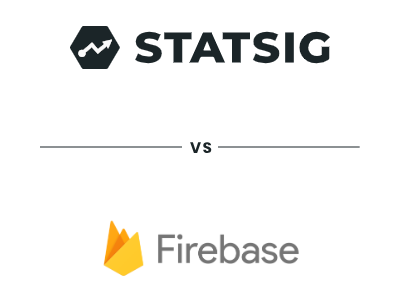
Once web and mobile apps are shipped, product teams should consider top-tier platforms for experimentation and performance monitoring.
Firebase, Supabase, and Parse all share a common purpose: they are Backend-as-a-Service (BaaS) platforms. They simplify backend development for web and mobile applications, providing developers with tools to manage databases, authentication, cloud storage, push notifications, and more.
Some of these platforms have broadened their offerings with a range of post-development tools, aimed at retaining developers. This suite includes capabilities like feature flagging and management, A/B testing, user targeting and segmentation, and real-time control functionalities.
This pits BaaS platforms in competition with specialized software experimentation companies such as Statsig and LaunchDarkly. While BaaS platforms integrate well with product teams' existing software stacks, they may not offer the same robust feature sets as other platforms.
Now, let’s explore Firebase and its alternatives in more detail.
What is Firebase?
Firebase is a cloud computing suite, equipping developers with tools to launch apps and games, integrating with various platforms like Android, iOS, JavaScript, Node.js, Java, Unity, PHP, and C++.
Firebase evolved from Envolve, a 2011 startup by James Tamplin and Andrew Lee, initially created for website chat functionalities. Noticing its use for syncing real-time data, such as game states, Tamplin and Lee launched Firebase in April 2012, pivoting from chat to focus on real-time data synchronization and backend services.
Google announced in 2014 that it acquired Firebase, tightly integrating it with existing services and turning it into an umbrella for a wide range of features beyond backend solutions. This includes experimentation and digital analytics.
In 2016, Google’s Firebase rolled out Remote Config, which includes feature flags, machine learning customization, and A/B testing. That was followed in 2017 when Google acquired Crashlytics, now merged under the Firebase brand, which brought tools for tracking app crash locations, offering users insights into app performance and user experience.
Pricing model: Firebase operates on a freemium pricing model with two main plans: the Spark Plan, a free tier with various service limits ideal for small projects or testing, and the Blaze Plan, a pay-as-you-go option offering greater flexibility and scalability, where costs depend on resource usage beyond free tier limits.
Starter tier: The Spark plan is free, including free storage, read and write capabilities, A/B testing and feature flagging, authentication, and hosting.
Growth tier: The Blaze Plan is a pay-as-you-go model for larger projects.
Notable features:
A/B testing
Authentication
BigQuery through Google Cloud
Google Analytics
Watch out for: With a broad set of features, customers should be cautious about the robustness of Firebase’s ancillary services. A user notes that its advanced analytics features are limited compared to specialized platforms. Another writes, “Some analytics we found not to be 100 percent accurate.”
The pricing model of Firebase, which bills operations such as database read/write and bandwidth used, can become a concern as user bases grow. For projects that are not generating revenue, this could lead to unexpectedly high costs as the application scales. One user warns customers to consider the “cost implications for small-sized businesses.”
The top Firebase alternatives
1. Statsig

Pricing model: Statsig offers unlimited seats, free feature flags, and easily-predictable .
Pro tier: Starting at $150/month
Enterprise and Warehouse-Native: Contact sales
Notable features:
Advanced Stats Engine (CUPED and Sequential Testing with Bayesian or Frequentist approaches)
Highly-rated in-house Support Team
Out-of-the-box metric attributes
Holdouts, Experiment Layers, Dynamic Configs, and more
Warehouse-native or cloud-based implementation
Change propagation within seconds
Summary: Founded by ex-Meta engineer Vijaye Raji, Statsig is an all-in-one tool for product experimentation, feature flagging, and analysis. The flexible platform offers both cloud-based and warehouse-native solutions to fit its users’ dynamic needs.
Already, it has racked up hundreds of favorable reviews, becoming a popular tool among developers and product teams. What began with a focus on smaller companies has expanded to include major tech players, counting big names like OpenAI, Microsoft, and Figma among its users.
Watch out for: One user notes the learning curve associated with Statsig, stating: “[Y]ou need to invest time to learn the system to unlock the most value from the platform.” The user commends the support team and documentation for being helpful but expresses a wish for “future iterations of the platform to include turn-key templates for more complicated setups such as multi-site/tenant.”
Statsig versus Firebase, head to head

2. Supabase

Pricing model: Supabase sells its services under a usage-based tier system.
Starter tier: The free tier offers up to 500MB database space, 1GB file storage, 5GB bandwidth, 50MB file uploads, 50,000 monthly active users, among other user limits.
Pro tier: The pro tier costs $25, including 8GB database space including 100GB file storage, 250GB bandwidth, 5GB file uploads, 100,000 monthly active users, 2 million edge function invocations, among other offerings.
Team tier: This tier costs $599 a month and includes everything in the pro plan, as well as SOC2, daily backups stored for two weeks, and standardized security questionnaire, among other features.
Enterprise: For pricing, Supabase asks prospective customers to contact sales. The tier includes designated Support manager & SLAs, on-premise support, full-time “premium” enterprise support, custom security questionnaires, and private Slack channel.
Notable features:
PostgreSQL database
Data storage
Real-time data
PostgreSQL extensions
Summary: Supabase pitches itself as an “open source Firebase alternative” built around PostgreSQL. Founded in 2020 by Paul Copplestone and Ant Wilson, the platform helps developers roll out a variety of features, including authentication, APIs, edge functions, subscriptions, storage, and vector embeddings.
Watch out for: A review of Supabase highlights two primary concerns among users. First, users find the platform’s integration capabilities to be lacking, affecting its functionality and third-party service connectivity. Second, there’s a lack of customization options for user-facing elements, like email templates, limiting users’ ability to personalize these features to fit specific brand or design needs.
3. Parse

Pricing model: Parse is an open-source platform, meaning costs will depend on server hosting, database, and any other related infrastructure services.
Notable features:
Analytics
Data synchronization
Database management
File storage
Summary: Parse is an open-source platform for mobile and web app development, offering BaaS features like object/file storage, user authentication, and push notifications. Initially a company acquired by Facebook in 2013, Parse was later shut down and re-released as an open-source project. It is now deployable on any Node.js-supporting infrastructure.
Watch out for: A user on a forum highlighted a critical issue with the Parse platform for backend services, stating, “Everything is allowed and enabled by default.” This setting, while convenient for development, raises security concerns. It requires developers to actively secure their apps and avoid configuration errors, to prevent potential security vulnerabilities.
4. Launchdarkly

Pricing model: Pro tier: $16.67/seat/month. Enterprise: Contact sales
Starter tier: $8.33/seat/month
Notable features:
A/B Testing
Scheduled rollouts
Feature flags
Summary: Launchdarkly is a SaaS platform that manages feature flags, feature rollouts, A/B tests, and the like. Founded in 2014, Launchdarkly was one of the first third-party feature flagging tools to gain widespread adoption by tech companies.
Watch out for: Launchdarkly users should be wary of its limited security and access management features. One user gripes, “User account creation and permission management are a mess. Our entire company uses it and each new user can see every single project within the console. I'd love it if users could only see the specific projects they have access rights to.”
Additional reading: The top 4 Launchdarkly alternatives.
Get a free account

